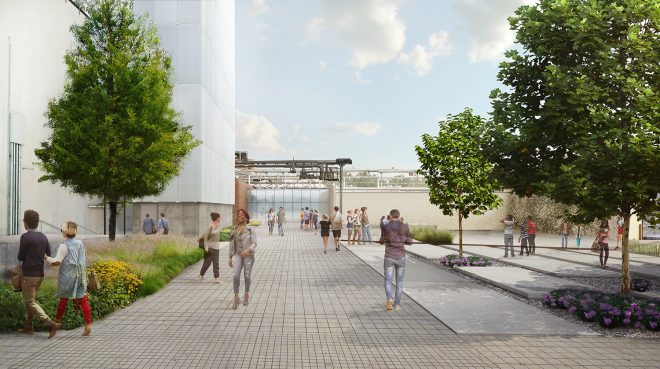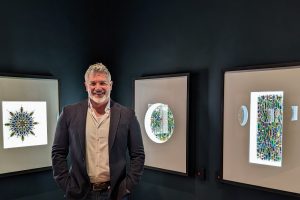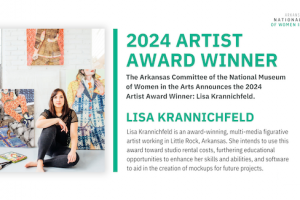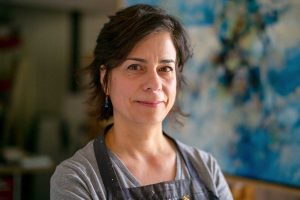A Chat with Lieven Bertels, Executive Director of The Momentary

INTERVIEW / ROBIN ATKINSON
Lieven Bertels is the Executive Director of the Momentary, the upcoming contemporary art center that is slated to open in February of 2020 in downtown Bentonville. Alongside exhibition space, the Momentary will house three dedicated studio spaces for short- to medium-term artist residency (with studio spaces dedicated to traditional, high-tech/multimedia, and 3D/sculptural) and social spaces to nurture collaboration. They envision studio and social spaces that provide artistic independence for artists residencies alongside an integrated art experience for guests that creates a holistic mix of art and leisure activities.

Lieven discussed his vision for the Momentary on July 17th at Crystal Bridges with Robin Atkinson, CEO of Arkansas Arts & Fashion Forum (publisher of The Idle Class).
Robin Atkinson: Contemporary art in Northwest Arkansas is a big step forward culturally. We had State of the Art at Crystal Bridges, which was Northwest Arkansas’s first foray into contemporary art. But, in terms of the larger population here, an actual contemporary art museum is kind of a leap. So what are the strategies that you’ll take on to help wade people into that whole realm?
Lieven Bertels: We are not going to be a museum. We are going to be a contemporary art center. What’s the difference? We don’t feel that historical pressure to collect and represent art history. And I think that’s very well reflected in the name, we want to be of this moment and we want to look at what is currently happening. As you go through time, it advances forward so you build your own history as an institution and you don’t work in a vacuum so you’re also referencing art history. We are in a very curious and unique position that with the Momentary, of course, we reference art history through Crystal Bridges. We hope to be a small and nimble and, you know, sort of gymnastically flexible – metaphorically speaking, art center, but to have a backbone in an amazing museum collection. There’s only a handful of contemporary art centers in this country that have that luxury. Some of them have it more as part of their DNA, like PS1 that can reference MoMA, some of it have a true partnership with nearby institutions like a Walker Art Center in Minneapolis, but they are few and far between and to have something like that in the heartland of the US, we think is pretty unique.
RA: Will the Crystal Bridges collection be on view at the Momentary in any given time, parts of it?
LB: Parts of it might be. We don’t have the same architectural features as the museum has, that’s another distinction between a museum and an art space. So we will have some spaces that are conditioned to contain art, in terms of temperature and humidity control, but our spaces are rough industrial spaces, so you can put some works on display there, but maybe not, you know, very precious Hudson School paintings; even if you would like to use those as reference. If we want to do that, we will have to create those museum conditions on special request. And we might, but that’s very specific. So some art forms, some techniques, some types of work lend themselves better than others to make that physical connection. Of course, given that we’re only a couple of miles apart you could very much imagine that there would be these twin sister shows where we have historical context and you have something bouncing off it, or you have new work that’s created with a historical painting as a starting point or you have a hybrid between performing arts or performative arts or music and visual arts with reference points in the museum collection. All of these combinations are possible.
RA: What are some of the strategies you plan to employ to help the regional audience to wade into the contemporary conversation?
LB: I think the best approach is to not constantly get hung up on that regional aspect. As in, we see ourselves as part of a national dialogue, which always will reference this place as our anchor point, but we want to aim nationally. That is true in the scope and scale of exhibitions, in the level of artists we want to work with, in the visitation we hope for, and that has been the same for Crystal Bridges Museum, of which we are a satellite project. We live under the same public foundation, so we are a public charity and we are part of Crystal Bridges. The current presentation statistics for Crystal Bridges are positive whatever way you look at them. Half of our visitation is from here, half of the visitation is from inter-state and nationally. That’s beautiful because it means that for Crystal Bridges, which is around 600,000 people a year, half of those visitors come from the region. Knowing that Northwest Arkansas only has a population of around 5-600,000 people that means that 1 in 2 of every inhabitants of this region, including babies and elderly, come to the museum at least once a year. So, in terms of serving a community, you can’t do much better. Imagine you were to extrapolate that number to London or New York, that’s insane. That would mean 5 million people a year would go through, locally, would go through a metropolitan museum. So that’s very positive, but it also means that we manage to drive people here for the museum with the other half.
Now of course, the Momentary’s a smaller project, it’s a little more niche, it’s specifically geared towards contemporary art. But we would hope that that kind of ratio will stay the same so we can serve whoever has an appetite for or whoever we can win the hearts and minds of to get an interest in contemporary art as well as visitors that say, “Hey, I can see Crystal Bridges, I can have an amazing dinner, I can stay in a really cool hotel, I can do some shopping, and I can go to this contemporary art center.”
How does that plan interact with the local community? A lot of artists that live in this region are super excited about finally getting the living artists in the limelight. When you say museum, for a lot of people out there, not us in the arts, but for a lot of people in the larger community, art is about dead people. Art is about people that became famous once their paintings, you know, it’s very white, it’s very male, and it’s very dead. That’s what a museum still for many people reflects. Contemporary art space could actually reflect community, who we are or our identity here in the heartland whether we talk about Northwest Arkansas, or the wider region, or even nationally, but with a strong focus on living artists. So it’s about commissioning, it’s about opportunities for the wider community to see how art gets made, who the people are that make art, what their story is, why they find certain narrative. We will invest more time and effort in having those touchpoints with the artists, making sure that when Artist XYZ comes here to a major show, people can really understand that these are living artists that tell the stories of our cities and our regions and that actually help us understand the world around us and the times we live in.
RA: How many spaces in the museum are thought of as dedicated to be studio space?
LB: We will have three dedicated studio spaces when we open. That might grow, but we are going to start with three. One more traditional, one very high-tech multimedia for video/sound artists or digital photography people that want to sit in the dark and edit photos, doing things that are on a computer or server, and one for more three-dimensional and sculptural pieces, like welding, traditional sculpture, bigger pieces. That gives us an opportunity to get a diverse group of artists. Of course, if we want to invite people in other media, we can make room for that, whether it’s in performing arts or performance art (and I make that distinction deliberately) and whether they want to spend time here for research, writing, dramaturgy, or whether they want to actually create work here or test it, all of those options are open to us.
RA: The length of stay would be between six weeks and six months. Do you plan to have all three spaces activated simultaneously?
LB: We do. We have also included some social space so that these artists also benefit from meeting each other. So, they can work, you know, they could come up with collaborative ideas as well between genres and between techniques. We very much want to give these artists a certain degree of independence and, I would say, more comfort.
There was a moment in German Art History where this whole workshop idea became almost like a zoo for artists and you could come and visit and see them work. That works well in academia perhaps, but not so much for an established artist, so we want to give them the freedom to work with their own rhythm. They won’t have to clock in with us and they won’t be employees at the museum. And so, therefore, we also want to carefully balance how often do they want to do an open studio day where the public gets the chance to see what’s going on and how often do they just want to be able to work? So, we will strive for some of the studio time so that the public really gets the understanding of what the artist is about and hopefully for them to share some of their experience and some of their work with the visiting public.
RA: I think collecting is a process that not many people in the region are truly familiar with. We do not have art fairs here in the way that, for example, Art Basel is an art fair. There are no biennials in the way that Prospect New Orleans or PS1 have biennials. So, interaction with discrete, purchasable art objects is relatively low. As a curator in your past positions, as the festival director, empresario, and now museum director, what has been your interaction with collectors as you helped lead these giant projects?
LB: Well, it’s interesting to see how different that is in different parts of the world and between different art forms. There are artists that live off a very collectable set of works. Photography, comes to mind. One thing, and you’re absolutely right in your question, is that in this part of the US, collecting isn’t something that seems to come naturally to a lot of people. We don’t have a huge group of collectors, but it’s nice to see that there is certainly a start and it’s growing. And, I don’t think it’s just due to Crystal Bridges or, in the future, the Momentary, it’s also what is happening in the ecosystem of arts and culture. If I think of two other initiatives that aren’t directly related to us, 21C and the opening of their hotel, and the step up for the arts curriculum at the university, where a proper arts school is now starting, those two initiatives really help in growing a community that takes an interest in owning art, because collecting starts [with] buying your first piece. When you look back, that will be the start of your collection. I think there is going to be great appetite for it as we go forward.
Often it starts with a relationship with an artist that you take an interest in, which is great news for local artists. A lot of people will start getting passionate about collecting by following the narrative, the story, the life of a particular living person, or artist that they engage. So, the more that we can create engagement with artists, the more opportunities there are for people both locally and nationally to come and tell their story and to grow, I wouldn’t call it a class of collectors, but a family of collectors. What we see a lot with our regional and national visitors to Crystal Bridges is that there are a lot of them that are collecting, often people that want to be closer to the museum. If you look at the group of private donors to the museum, many of those people have a passion for arts that they also show through their collecting activity.
Everybody can collect on their own level. There has been this massive misconception by many people that collecting is something you would do if you had excess money, it was something you would do as a luxury. Funnily enough I come from Belgium, from Flanders, and since the mid 60’s there has been a real growing group of people who weren’t necessarily having that luxury of excess money who would still collect art, it was just something you would do. If it wasn’t a priceless oil painting, it could have been a lithograph and if it wasn’t a lithograph, it could have been a modern multiple like collecting photography. People would just aspire to that. True pop art and regional style like Cobra, people in Europe would start collecting all kinds of works and every random family would aspire to have at least one mantle piece that they would literally hang above the chimney as, “Look, we have a Karel Appel lithography and we don’t know what it means but it’s beautiful and colorful.” It was a conversation starter.
One of the things I really like is that idea of the conversation with the living artist in collecting. I don’t think that collecting art is the same as collecting stamps or collecting firearms or collecting sport memorabilia. Though, sport memorabilia, funnily enough, often are about the story as well. You getting that one autographed baseball and it’s about you having had the connection with your hero. With art, it’s more layered. You want to have a relation with a piece, it’s very hard to collect works you don’t actually like. It’s very hard to pretend in your collecting because you grow away from those pieces in your collection so you will absolutely want to follow your gut feeling in collecting. But typically you also want to know about the artist behind the work. So, that’s where I hope something like the Momentary can play a role as a conduit. Of course, we’re only one part in the large jigsaw puzzle in a art ecosystem because, as you mention, biennials can be a part of that, major art fairs can be a part of that, galleries can be a part of that. We don’t have all these pieces in place in the same way that major cities and metropolitan centers would have but we have sometimes developed our own way of doing things in this region. That’s where 21C comes in, that’s where building a relationship with artists when they are very young comes in and having a university with a strong arts curriculum would help with growing that.
RA: And the Momentary will be a place for people to engage with that artist conversation?
LB: We hope that it won’t be a passive place of art consumption. We hope it will also be a meeting place and we take that quite literally. In a museum there’s a certain set of rules and expectations that you have your cafeteria and you have the museum. They’re like oil and vinegar. We want to mix that up. We want to allow you to come and work with your laptop in amongst contemporary art. We want you to have a conversation with your friends in amongst the artworks. We want you to come and hangout with your friends, or your family, grab a really great quality coffee, and then have an art fix. I think that’s another one of those unique things that we can offer.
RA: It reminds me of the move of Relational Aesthetics into the art centers in Europe in the 90’s. A lot of that ended up getting codified, again, by the museum. It was sort of that wall that contemporary art bumps up against where, all the sudden, then it’s an object and people get confused about that relational aspect. So, are there any steps that you’re thinking about to keep it from codifying in the same language of a museum?
LB: I think you do that together with your community and I think they might be the future strength of our region. The lines are pretty short here, we know each other, and it’s a small tightly knit community. Which, for an art center, is a great benefit. One of the things that art centers and that European model struggled with as they grew is that they lose the direct touch with their public. I hope that we can remain nimble. In this day and age, and I think this is the difference between the 90’s and today, a lot of us art consumers, potential public, lovers of art and some professionals in the art world have grown up to understand that the internet isn’t the one-step solution to interacting with each other.
We can spend a great deal of time on devices, but ultimately we still crave social exchange. So, that’s where I think the art center 2.0 is what’s different from what happened in the 80’s and 90’s. The idea that we want to come back together. Not so much that we want to come together, but that we want to come back together. That’s the slight difference, I think. It’s a 360 degree thing. You want to come together to share food, you want to come together share an outdoor experience. To be silly, to have a party, to go to a festival, to go to a fashion show, to go shopping, and to have an art fix. There’s some great digital art that you could consume on a fancy, flat screen TV and it would look just as great as it did in a museum, maybe better! But, it’s not the same experience and I think that the ‘win’ is the fact that you can come together and experience this together.
Images courtesy of Crystal Bridges





Comments